You're using an outdated browser. Please upgrade to a modern browser for the best experience.
Please note this is a comparison between Version 2 by Rita Xu and Version 1 by Zhengguang Liu.
In response to the urgent need to address climate change and reduce carbon emissions, there has been a growing interest in innovative approaches that integrate AI and CDR technology.
- climate change
- low carbon
- sustainable development
1. Introduction
1.1. Research Background
Carbon Dioxide Removal (CDR) technology and Artificial Intelligence (AI) are two prominent fields that have gained significant attention in recent years [1,2,3][1][2][3]. CDR technology focuses on the removal of carbon dioxide from the atmosphere [4], while AI encompasses the development of intelligent systems capable of performing tasks that typically require human intelligence [5,6][5][6]. The integration of CDR technology and AI presents a compelling opportunity to optimize energy systems and address the challenges of climate change. CDR technology aims to mitigate climate change by actively removing carbon dioxide from the atmosphere or capturing it from emission sources [7]. Various CDR methods have been proposed and developed including Direct Air Capture (DAC) [8], which extracts CO2 directly from ambient air, and Bioenergy Carbon Capture and Storage (BECCS), which combines biomass energy production with carbon capture and storage [9,10][9][10]. These technologies offer the potential to reduce carbon emissions and contribute to a more sustainable future. Figure 1 shows the important role of AI in CO2 emission reduction. The left scheme corresponds to an AI-based GHG sequestrating cycle. The right scheme describes the role of AI software in this scheme.

Figure 1. High-level schemes of AI-based GHG sequestrating.
Additionally, AI has demonstrated remarkable capabilities in data analysis, pattern recognition, and optimization [11]. By harnessing the power of AI, energy systems can be optimized to achieve greater efficiency, reduce the carbon footprint, and improve overall performance. The integration of CDR technology and AI holds significant promise for energy system optimization. AI techniques can enhance CDR technologies in several ways including accurate assessment and monitoring of carbon emissions, optimization of deployment and operation of CDR facilities, and real-time monitoring and adaptive control based on changing conditions [12].
The motivation behind integrating CDR technology and AI lies in the urgent need to address climate change and transition to a sustainable energy future. The rising levels of carbon dioxide in the atmosphere and the associated environmental consequences necessitate effective strategies to reduce emissions and remove existing carbon [13]. By combining CDR technology and AI, wresearchers can enhance the efficiency and effectiveness of carbon removal processes, optimize energy systems, and accelerate the transition to a low-carbon economy. The integration of CDR technology and AI presents a unique opportunity to optimize energy systems and mitigate climate change.
1.2. Overview of CDR Technology
Carbon Dioxide Removal (CDR) technology encompasses various methods and approaches aimed at removing carbon dioxide from the atmosphere or capturing it from emission sources. Here are some common CDR technologies.
-
Direct Air Capture (DAC)
Principle: DAC technology directly extracts carbon dioxide from ambient air using chemical sorbents or membranes [14]. Application Scope: DAC can be deployed in various locations including industrial sites, power plants, or even directly in the atmosphere. Potential Challenges: DAC technologies face challenges related to energy consumption, cost-effectiveness, and scalability. Developing efficient and cost-competitive sorbents and optimizing the capture process are ongoing areas of research. Figure 2 shows the levelized cost projections for CO2 direct air capture in 2050.
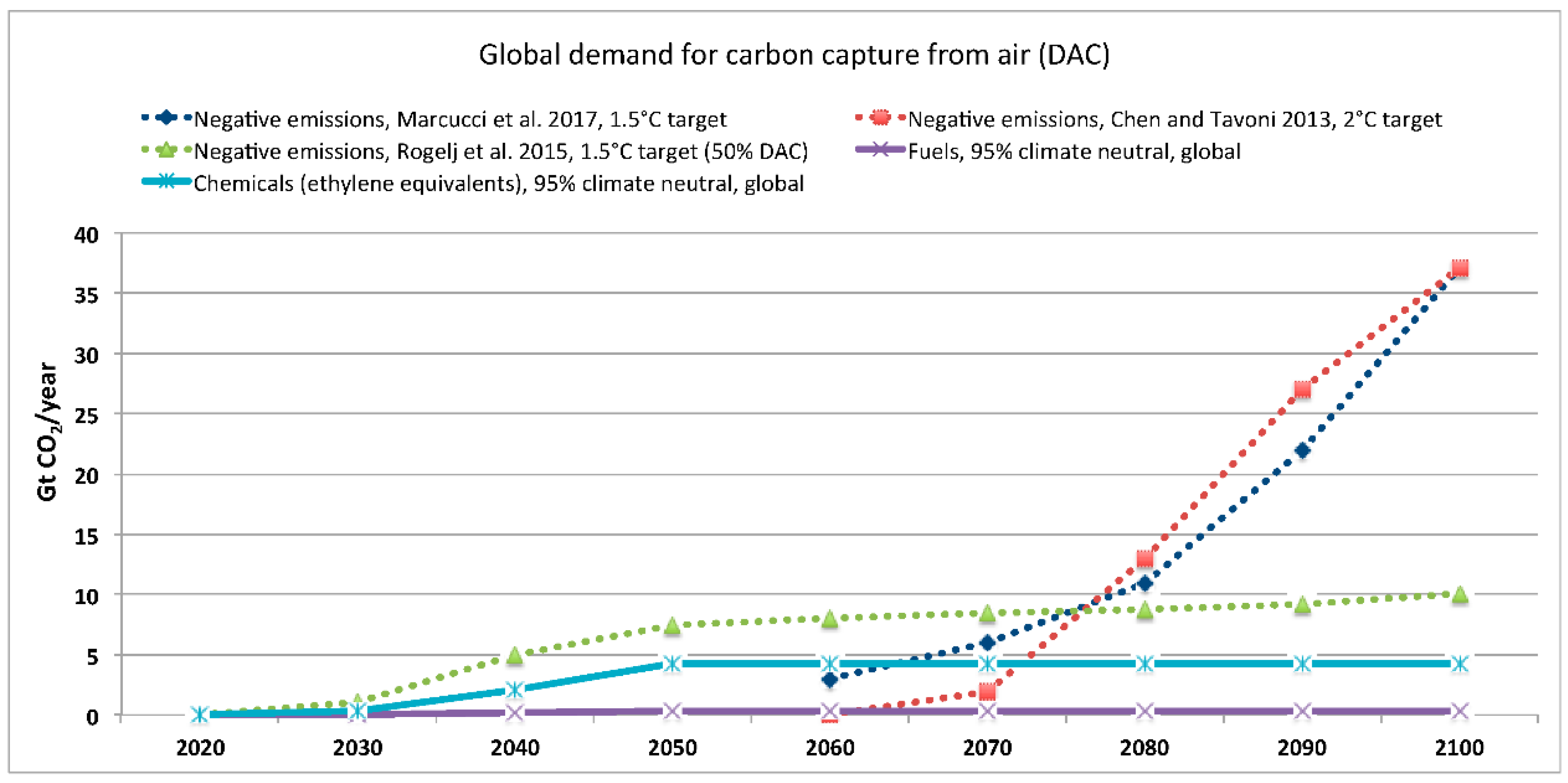
Figure 2. Global Direct Air Capture (DAC) demand for achieving negative emissions from 2060 in comparison with globally required climate-neutral CO2 for Power-to-Liquids and Power-to-Chemicals in Gt CO2/year.
-
Bioenergy Carbon Capture and Storage (BECCS)
Principle: BECCS combines biomass energy production with carbon capture and storage. The process flow diagram in Figure 3 depicts the operations during the harvest season, which involves steam extraction for industrial processes and includes CCS. Biomass plants capture CO2 emissions generated during energy production and store them underground [19][15]. Application Scope: BECCS can be implemented in power plants, industrial facilities, or dedicated biomass production facilities. Potential Challenges: Challenges include ensuring sustainable biomass feedstock supply, optimizing the energy balance of the process, and addressing potential environmental impacts associated with large-scale biomass cultivation.
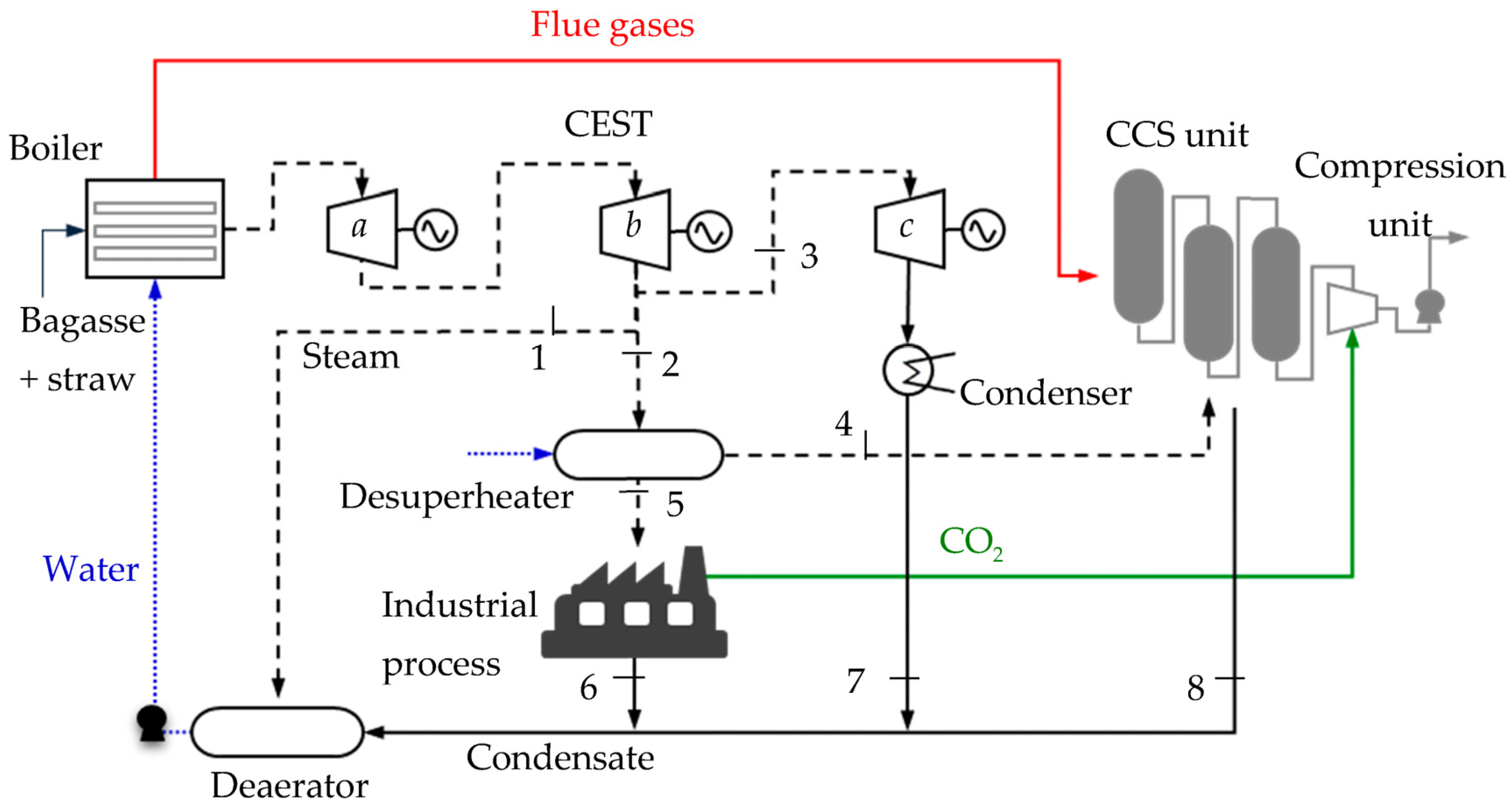
Figure 3. BECCS process flow diagram (harvest season).
-
Carbon Sequestration
Principle: Carbon sequestration involves capturing and storing carbon dioxide emissions in geological formations, such as depleted oil and gas reservoirs or deep saline aquifers [21][16]. Application Scope: Carbon sequestration can be applied to various emission sources including power plants and industrial facilities. Potential Challenges: Challenges include selecting suitable storage sites, ensuring the long-term integrity of the storage reservoirs, and addressing public perception and regulatory concerns surrounding the safety and permanence of storage.
-
Enhanced Weathering
Principle: Enhanced weathering involves accelerating natural weathering processes to capture and store carbon dioxide [22][17]. It typically involves the application of minerals or rocks that react with CO2 and permanently sequester it. Figure 4 illustrates a conceptual diagram that presents the strategies of CCS through mineral carbonation. Application Scope: Enhanced weathering can be applied to agricultural lands, coastal areas, or specific carbon capture facilities. Potential Challenges: Challenges include identifying suitable mineral sources, assessing the environmental impact of large-scale mineral deployment, and understanding the long-term stability of carbon storage.
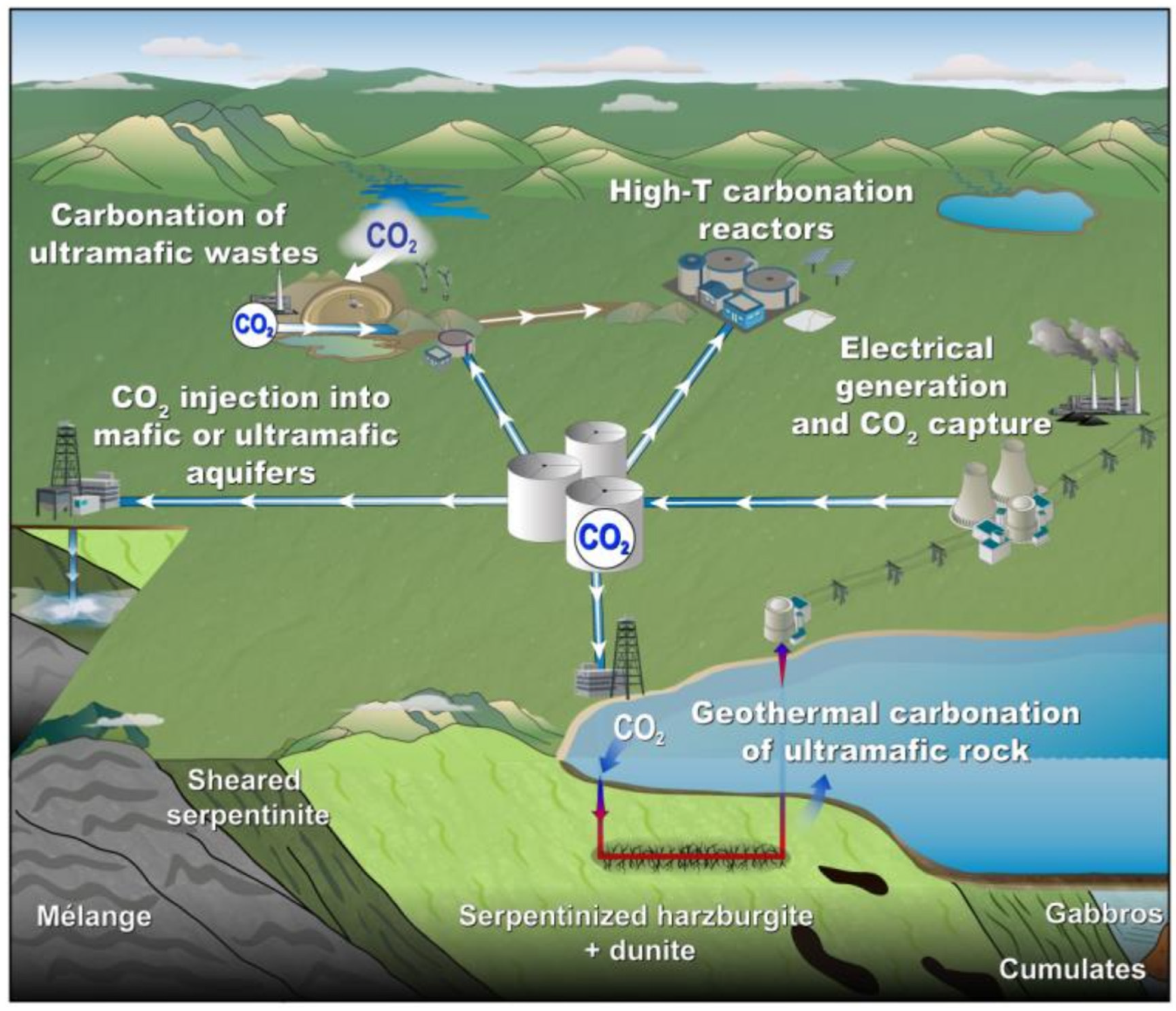
Figure 4. Visual graphics of enhanced weathering processes.
2. Integration of “CDR + AI”
The integration of CDR Technology and Artificial Intelligence (AI) offers several potential advantages, including four parts as follows:
2.1. Accurate Carbon Emissions Assessment
By combining CDR technology and AI, it becomes possible to accurately assess and quantify carbon emissions. Figure 5 shows an overview of the thematic dimensions included in the technical feasibility assessment of CDR removal. AI algorithms can analyze large amounts of data from various sources, including CDR facilities, industrial processes, and energy consumption patterns, to provide more precise estimations of carbon emissions. This can help in identifying high-emission areas, tracking progress towards emission reduction goals, and informing policy decisions [25][18].
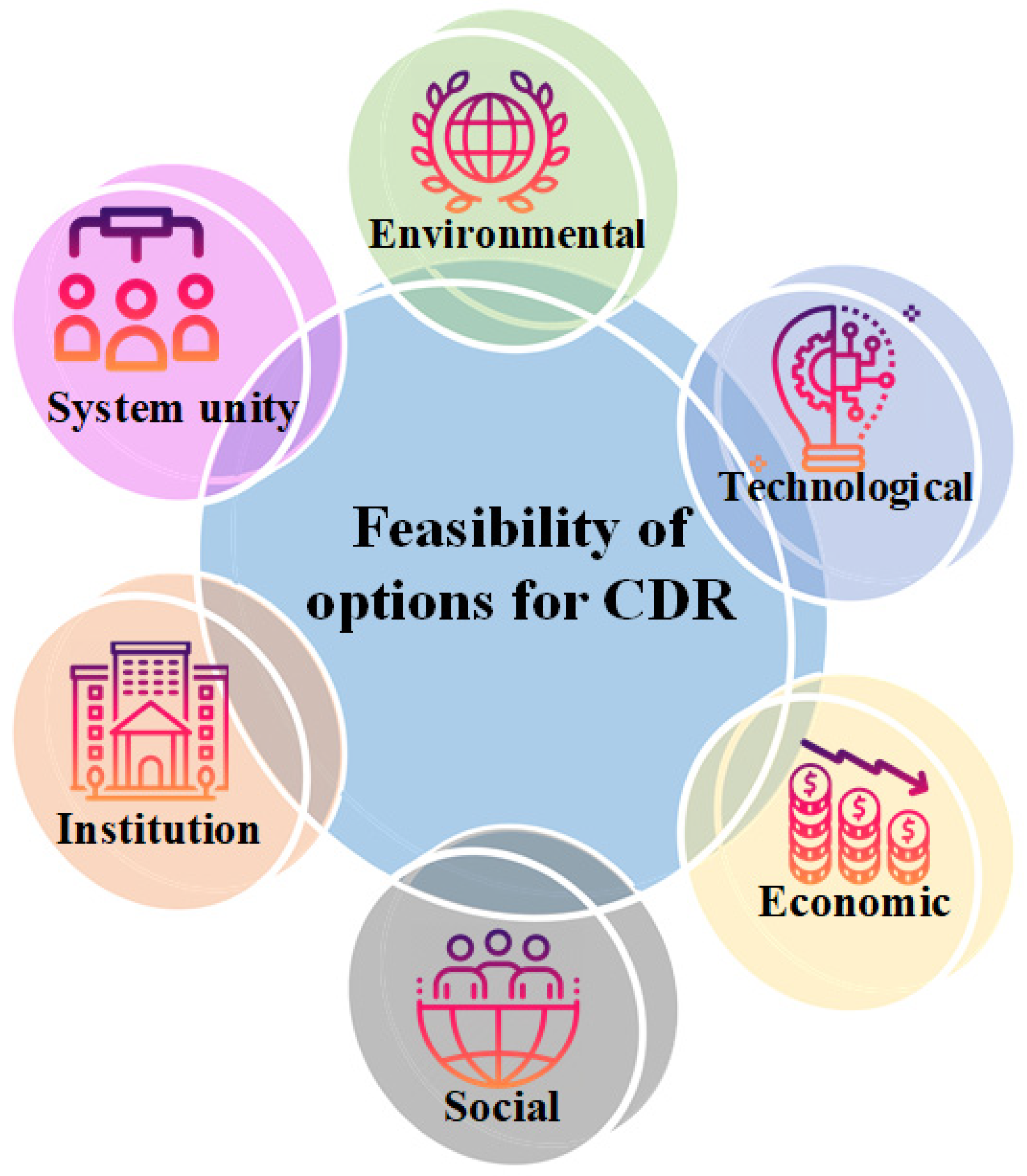
Figure 5. Overview of thematic dimensions included in the feasibility assessment framework of CDR options.
AI algorithms can integrate and analyze data from multiple sources, including emissions inventories, satellite imagery, sensor networks, and industry-specific data, to gain a comprehensive understanding of emissions across different sectors and regions [26][19]. By analyzing emissions-related data, AI can identify the spatial and temporal patterns of emissions, such as emission hotspots or areas with significant emission fluctuations, and pinpoint the high-emission areas that may require targeted interventions [27][20]. Machine learning techniques enable AI models to recognize emission patterns and make predictions based on historical data [28][21], identifying areas with a higher likelihood of being high-emission areas [29,30][22][23].
Satellite imagery provides valuable information on greenhouse gas concentrations, land-use changes, and industrial activities [31,32][24][25], which AI algorithms can process and analyze to identify regions with higher emissions and track changes over time [33][26]. Integrating data from sensors and IoT devices enables real-time monitoring of emissions, facilitating the identification of areas experiencing sudden spikes or persistent high emissions [34,35][27][28]. By visualizing emissions data spatially and using geospatial analysis techniques, AI can provide intuitive representations of high-emission areas [36,37][29][30]—making it easier for policymakers and stakeholders to identify regions that require targeted mitigation strategies [38][31].
By leveraging these capabilities, AI algorithms can assist in identifying high-emission areas, providing valuable insights into the sources and patterns of emissions. This information can guide policymakers in developing targeted interventions, implementing emission reduction measures, and prioritizing areas for mitigation efforts.
2.2. Optimized Energy System Configuration
AI algorithms can optimize the integration of CDR technology into energy systems by analyzing data on energy demand, renewable energy generation [39][32], and other factors to identify the most efficient and cost-effective ways to reduce carbon emissions and improve overall system efficiency [40,41][33][34]. By maximizing the use of renewable energy sources, AI can help reduce carbon emissions. Figure 6 is a schematic of a low-carbon energy system.
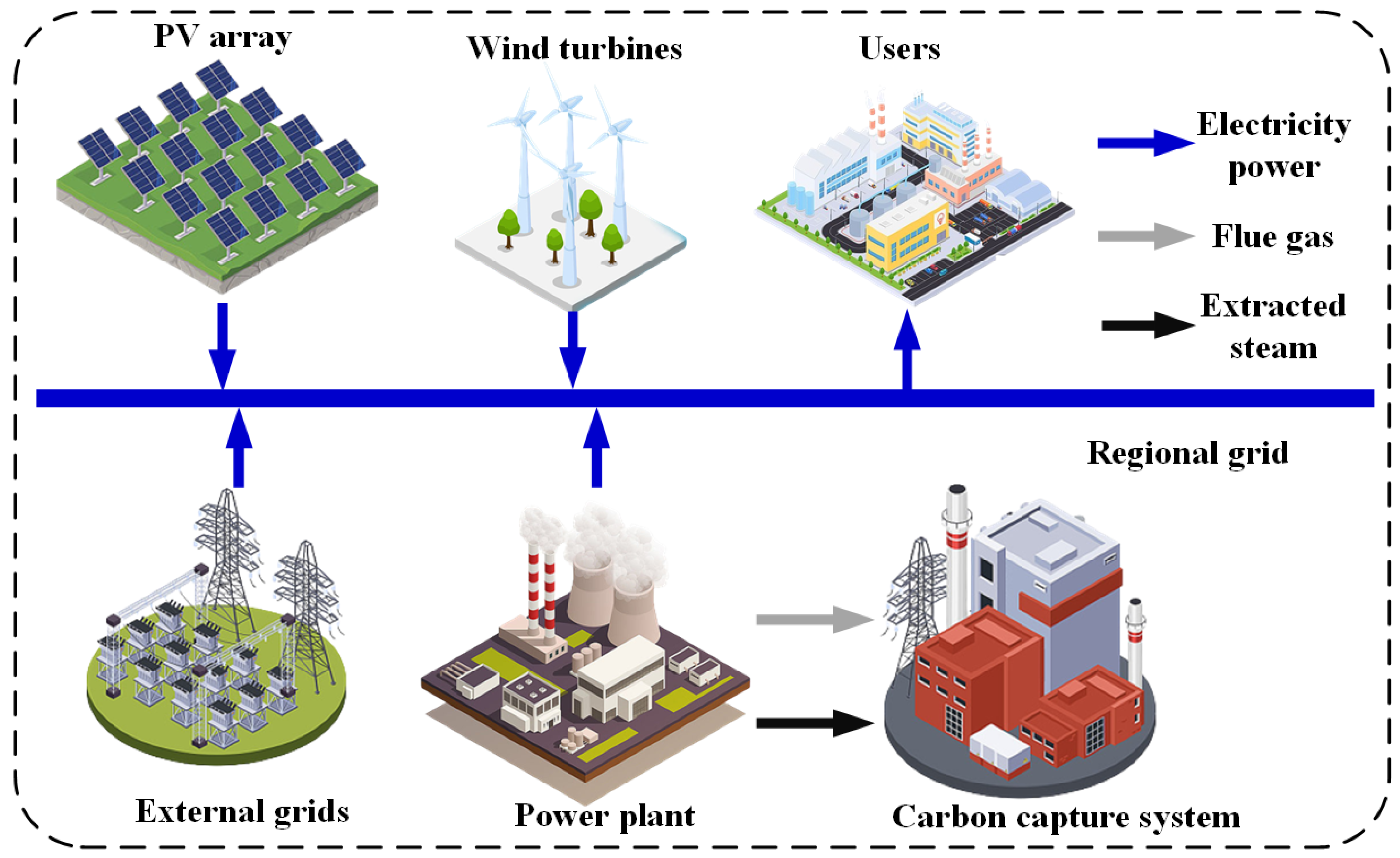
Figure 6. The schematic diagram of a low-carbon energy system.
AI algorithms can analyze extensive datasets related to energy demand, renewable energy generation, grid infrastructure, and other relevant factors [42,43][35][36]. By processing this data, AI models can build sophisticated models that capture the complexities of an energy system including the interplay between different energy sources, demand patterns, and carbon emissions [40,44][33][37]. These models enable scenario analysis and optimization to identify efficient and cost-effective configurations for integrating CDR technology [45][38]. Considering factors such as energy demand, renewable energy availability, storage capacities, and carbon removal targets, AI algorithms simulate and evaluate different system configurations [46,47][39][40]. This facilitates the identification of optimal solutions that maximize renewable energy use, minimize carbon emissions, and achieve specific energy and carbon removal objectives.
AI algorithms also optimize demand-side management strategies by analyzing energy demand patterns [12,48][12][41]. By leveraging machine learning techniques, AI identifies demand response opportunities, predicts peak energy demand periods, and optimizes the scheduling of energy-consuming activities [49,50][42][43]. This helps balance energy supply and demand, reduce reliance on fossil fuel-based energy generation, and increase the integration of renewable energy and CDR technologies. AI enhances the accuracy of renewable energy forecasting by analyzing historical weather data, renewable energy generation data, and other variables [51,52][44][45]. Accurate predictions of renewable energy availability enable the optimization of CDR facility scheduling and operation, aligning them with high renewable energy generation and low grid demand [53,54][46][47]. Furthermore, AI algorithms optimize energy system configurations by analyzing historical and real-time data on energy supply and demand, market prices, weather conditions, and other factors [55][48]. This analysis identifies opportunities for energy storage deployment, demand shifting, and smart grid management [56][49], ensuring stability, accommodating intermittent renewable energy sources, and effectively integrating CDR technologies [39][32].
By leveraging AI capabilities, energy system operators, policymakers, and stakeholders can optimize energy system configurations to maximize CDR technology benefits. This includes minimizing carbon emissions, maximizing renewable energy use, and improving overall system efficiency and resilience.
2.3. Real-Time Monitoring and Scheduling of CDR Facilities
AI enables the real-time monitoring and adaptive control of CDR facilities. By analyzing data from sensors, AI algorithms can continuously monitor the performance and operation of CDR facilities, detecting any anomalies or inefficiencies [57][50]. This allows for timely adjustments and optimizations, ensuring optimal utilization of resources and maximization of the carbon removal capacity of the facilities. Figure 7 displays a map depicting the global distribution of CCUS facilities with a specific focus on Europe.
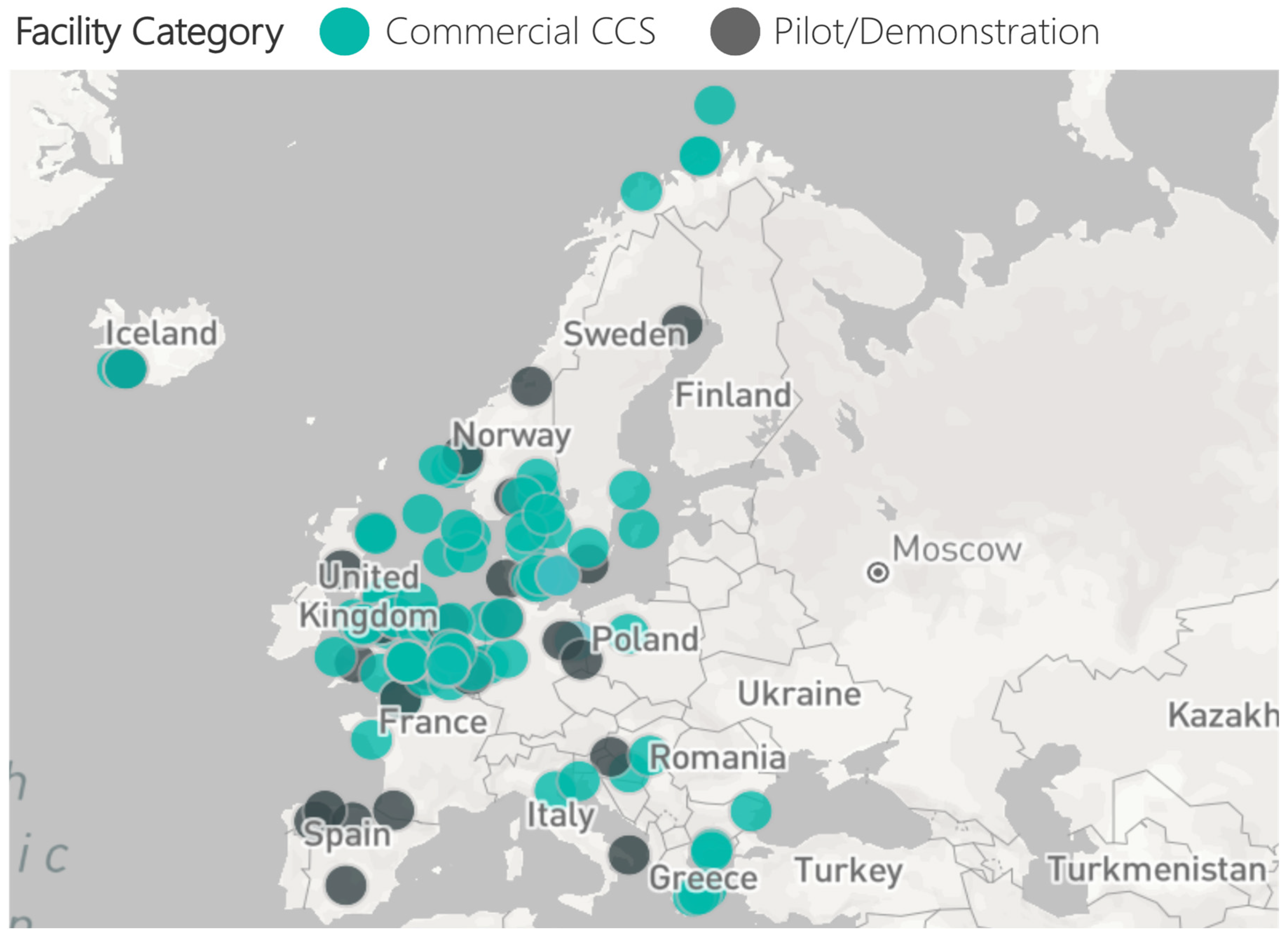
Figure 7. Worldwide distribution of CCUS facilities divided by categories, expanded in Europe.
AI algorithms integrate data from various sensors and monitoring devices installed in CDR facilities [59,60][51][52]. This includes parameters like temperature, pressure, flow rates, and capture efficiency. By continuously analyzing real-time data, AI monitors the performance of CDR facilities, detects anomalies or deviations from optimal conditions, and alerts operators to potential issues [61,62][53][54]. Anomaly detection techniques help identify abnormal behavior or malfunctions [63][55], triggering alarms or notifications by comparing real-time sensor data with historical patterns and predefined thresholds. Operators can take immediate corrective actions, minimizing disruptions in the carbon removal process. AI also predicts maintenance needs and schedules proactive maintenance activities, optimizing facility availability and reliability [64][56].
AI dynamically adjusts CDR facility operations based on real-time data and changing conditions. By monitoring factors like energy availability, carbon capture efficiency, and storage capacity, AI optimizes scheduling and resource allocation. This enables adaptive control strategies that maximize carbon removal capacity, optimize energy consumption, and respond to fluctuations in renewable energy generation or demand. AI optimizes resource allocation within CDR facilities, considering real-time data on energy availability, cost, and carbon removal targets. This determines the most efficient allocation of resources for optimal carbon removal performance, minimizing costs while maximizing capacity. AI integrates with energy grid data and market signals to schedule CDR facilities. Considering electricity prices, demand peaks, and renewable energy availability, AI schedules carbon removal processes during periods of low electricity demand or high renewable energy availability. This maximizes renewable energy utilization, reduces costs, and aligns carbon removal activities with grid conditions.
2.4. Mutual Benefits and Mechanisms
The integration of CDR technology and AI can lead to mutual benefits and synergies [65][57]. CDR technology can provide data for AI model training and improvement, while AI optimization methods can improve the efficiency of CDR technology. The data collected from CDR facilities can be used to train AI models and enhance their accuracy and efficiency. AI algorithms can analyze complex datasets and optimize the operation and performance of CDR facilities, leading to increased carbon removal efficiency and reduced operational costs [22][17].
CDR facilities generate a wealth of data that can be utilized to train AI models [3]. By incorporating this data into the training process, AI algorithms can learn from real-world CDR operations and improve their accuracy and efficiency. This leads to more effective AI models that can make better decisions and optimizations in CDR technology [66][58].
AI algorithms can optimize the operation and performance of CDR facilities by analyzing complex datasets and identifying patterns and correlations [67][59]. This enables AI to make informed decisions and adjustments in real-time, enhancing the efficiency and effectiveness of CDR technology. AI algorithms can optimize various aspects of CDR technology processes, including capture, storage, and utilization of carbon dioxide, leading to cost reductions, energy savings, and increased carbon removal capacity.
AI algorithms can enable CDR systems to be adaptive and responsive to changing conditions by continuously analyzing real-time data. This adaptability allows CDR systems to optimize their performance in response to variations in energy supply, carbon emissions, and other relevant factors, ensuring effective carbon removal in real-time [68][60]. AI can also play a crucial role in planning the deployment and scalability of CDR technology by analyzing various factors and optimizing the allocation of resources [69][61].
The integration of CDR technology and AI creates a symbiotic relationship that enables improved carbon removal capabilities, cost-effectiveness, and scalability. This synergy contributes to the mitigation of climate change by offering accurate carbon emissions assessments, optimized energy system configurations, and real-time monitoring and scheduling of CDR facilities. The mutual benefits between CDR technology and AI can drive advancements in both fields, leading to more efficient and effective carbon removal solutions.
References
- Honegger, M.; Michaelowa, A.; Roy, J. Potential implications of carbon dioxide removal for the sustainable development goals. Clim. Policy 2021, 21, 678–698.
- Hopster, J. The ethics of disruptive technologies: Towards a general framework. In Proceedings of the International Conference on Disruptive Technologies, Tech Ethics and Artificial Intelligence, Salamanca, Spain, 15–17 September 2021; Springer: Berlin/Heidelberg, Germany, 2021; pp. 133–144.
- Yan, Y.; Borhani, T.N.; Subraveti, S.G.; Pai, K.N.; Prasad, V.; Rajendran, A.; Nkulikiyinka, P.; Asibor, J.O.; Zhang, Z.; Shao, D.; et al. Harnessing the power of machine learning for carbon capture, utilisation, and storage (CCUS)—A state-of-the-art review. Energy Environ. Sci. 2021, 14, 6122–6157.
- Terlouw, T.; Bauer, C.; Rosa, L.; Mazzotti, M. Life cycle assessment of carbon dioxide removal technologies: A critical review. Energy Environ. Sci. 2021, 14, 1701–1721.
- Wang, H.; Fu, T.; Du, Y.; Gao, W.; Huang, K.; Liu, Z.; Chandak, P.; Liu, S.; Van Katwyk, P.; Deac, A.; et al. Scientific discovery in the age of artificial intelligence. Nature 2023, 620, 47–60.
- Fuso Nerini, F.; Fawcett, T.; Parag, Y.; Ekins, P. Personal carbon allowances revisited. Nat. Sustain. 2021, 4, 1025–1031.
- Beuttler, C.; Charles, L.; Wurzbacher, J. The role of direct air capture in mitigation of anthropogenic greenhouse gas emissions. Front. Clim. 2019, 1, 10.
- Lackner, K.S. The thermodynamics of direct air capture of carbon dioxide. Energy 2013, 50, 38–46.
- Consoli, C. Bioenergy and Carbon Capture and Storage; Global CCS Institute: Washington, DC, USA, 2019.
- Withey, P.; Johnston, C.; Guo, J. Quantifying the global warming potential of carbon dioxide emissions from bioenergy with carbon capture and storage. Renew. Sustain. Energy Rev. 2019, 115, 109408.
- Salehi, H.; Burgueño, R. Emerging artificial intelligence methods in structural engineering. Eng. Struct. 2018, 171, 170–189.
- Rocha, H.R.; Honorato, I.H.; Fiorotti, R.; Celeste, W.C.; Silvestre, L.J.; Silva, J.A. An Artificial Intelligence based scheduling algorithm for demand-side energy management in Smart Homes. Appl. Energy 2021, 282, 116145.
- Hepburn, C.; Adlen, E.; Beddington, J.; Carter, E.A.; Fuss, S.; Mac Dowell, N.; Minx, J.C.; Smith, P.; Williams, C.K. The technological and economic prospects for CO2 utilization and removal. Nature 2019, 575, 87–97.
- Erans, M.; Sanz-Pérez, E.S.; Hanak, D.P.; Clulow, Z.; Reiner, D.M.; Mutch, G.A. Direct air capture: Process technology, techno-economic and socio-political challenges. Energy Environ. Sci. 2022, 15, 1360–1405.
- Mishra, A.; Kumar, M.; Medhi, K.; Thakur, I.S. Biomass energy with carbon capture and storage (BECCS). In Current Developments in Biotechnology and Bioengineering; Elsevier: Amsterdam, The Netherlands, 2020; pp. 399–427.
- Mosleh, M.H.; Sedighi, M.; Babaei, M.; Turner, M. Geological sequestration of carbon dioxide. In Managing Global Warming; Elsevier: Amsterdam, The Netherlands, 2019; pp. 487–500.
- Goll, D.S.; Ciais, P.; Amann, T.; Buermann, W.; Chang, J.; Eker, S.; Hartmann, J.; Janssens, I.; Li, W.; Obersteiner, M.; et al. Potential CO2 removal from enhanced weathering by ecosystem responses to powdered rock. Nat. Geosci. 2021, 14, 545–549.
- Chen, X.; Wu, X.; Lee, K.Y. The mutual benefits of renewables and carbon capture: Achieved by an artificial intelligent scheduling strategy. Energy Convers. Manag. 2021, 233, 113856.
- Liao, M.; Lan, K.; Yao, Y. Sustainability implications of artificial intelligence in the chemical industry: A conceptual framework. J. Ind. Ecol. 2022, 26, 164–182.
- Wang, Y.; Ciais, P.; Broquet, G.; Bréon, F.-M.; Oda, T.; Lespinas, F.; Meijer, Y.; Loescher, A.; Janssens-Maenhout, G.; Zheng, B.; et al. A global map of emission clumps for future monitoring of fossil fuel CO2 emissions from space. Earth Syst. Sci. Data 2019, 11, 687–703.
- Masood, A.; Ahmad, K. A review on emerging artificial intelligence (AI) techniques for air pollution forecasting: Fundamentals, application and performance. J. Clean. Prod. 2021, 322, 129072.
- Ağbulut, Ü. Forecasting of transportation-related energy demand and CO2 emissions in Turkey with different machine learning algorithms. Sustain. Prod. Consum. 2022, 29, 141–157.
- Ghahramani, M.; Pilla, F. Analysis of carbon dioxide emissions from road transport using taxi trips. IEEE Access 2021, 9, 98573–98580.
- Fascista, A. Toward integrated large-scale environmental monitoring using WSN/UAV/Crowdsensing: A review of applications, signal processing, and future perspectives. Sensors 2022, 22, 1824.
- Riahi, K.; Van Vuuren, D.P.; Kriegler, E.; Edmonds, J.; O’neill, B.C.; Fujimori, S.; Bauer, N.; Calvin, K.; Dellink, R.; Fricko, O.; et al. The Shared Socioeconomic Pathways and their energy, land use, and greenhouse gas emissions implications: An overview. Glob. Environ. Chang. 2017, 42, 153–168.
- Leue, C.; Wenig, M.; Wagner, T.; Klimm, O.; Platt, U.; Jähne, B. Quantitative analysis of NO x emissions from Global Ozone Monitoring Experiment satellite image sequences. J. Geophys. Res. Atmos. 2001, 106, 5493–5505.
- Zhang, X.; Shu, K.; Rajkumar, S.; Sivakumar, V. Research on deep integration of application of artificial intelligence in environmental monitoring system and real economy. Environ. Impact Assess. Rev. 2021, 86, 106499.
- Syafrudin, M.; Alfian, G.; Fitriyani, N.L.; Rhee, J. Performance analysis of IoT-based sensor, big data processing, and machine learning model for real-time monitoring system in automotive manufacturing. Sensors 2018, 18, 2946.
- Park, J.; Yang, B. GIS-enabled digital twin system for sustainable evaluation of carbon emissions: A case study of Jeonju city, south Korea. Sustainability 2020, 12, 9186.
- Requia, W.J.; Roig, H.L.; Koutrakis, P.; Adams, M.D. Modeling spatial patterns of traffic emissions across 5570 municipal districts in Brazil. J. Clean. Prod. 2017, 148, 845–853.
- Cui, Q.; Jia, Z.-k. Transfer of embodied carbon emissions from provincial transportation industry in China. Multimodal Transp. 2023, 2, 100105.
- Chen, X.; Wu, X. The roles of carbon capture, utilization and storage in the transition to a low-carbon energy system using a stochastic optimal scheduling approach. J. Clean. Prod. 2022, 366, 132860.
- Huang, Q.; Amin, W.; Umer, K.; Gooi, H.B.; Eddy, F.Y.S.; Afzal, M.; Shahzadi, M.; Khan, A.A.; Ahmad, S.A. A review of transactive energy systems: Concept and implementation. Energy Rep. 2021, 7, 7804–7824.
- Jiang, A.; Yuan, H.; Li, D.; Tian, J. Key technologies of ubiquitous power Internet of Things-aided smart grid. J. Renew. Sustain. Energy 2019, 11, 062702.
- Şerban, A.C.; Lytras, M.D. Artificial intelligence for smart renewable energy sector in europe—Smart energy infrastructures for next generation smart cities. IEEE Access 2020, 8, 77364–77377.
- Cheng, L.; Yu, T. A new generation of AI: A review and perspective on machine learning technologies applied to smart energy and electric power systems. Int. J. Energy Res. 2019, 43, 1928–1973.
- Wu, C.-J.; Raghavendra, R.; Gupta, U.; Acun, B.; Ardalani, N.; Maeng, K.; Chang, G.; Aga, F.; Huang, J.; Bai, C.; et al. Sustainable ai: Environmental implications, challenges and opportunities. Proc. Mach. Learn. Syst. 2022, 4, 795–813.
- Migo-Sumagang, M.V.; Aviso, K.B.; Foo, D.C.; Short, M.; Nair, P.N.S.B.; Tan, R.R. Optimization and decision support models for deploying negative emissions technologies. PLoS Sustain. Transform. 2023, 2, e0000059.
- Tariq, R.; Cetina-Quiñones, A.; Cardoso-Fernández, V.; Daniela-Abigail, H.-L.; Soberanis, M.E.; Bassam, A.; De Lille, M.V. Artificial intelligence assisted technoeconomic optimization scenarios of hybrid energy systems for water management of an isolated community. Sustain. Energy Technol. Assess. 2021, 48, 101561.
- Zhang, Z.; Yang, X.; Yang, L.; Wang, Z.; Huang, Z.; Wang, X.; Mei, L. Optimal configuration of double carbon energy system considering climate change. Energy 2023, 283, 129188.
- Menos-Aikateriniadis, C.; Lamprinos, I.; Georgilakis, P.S. Particle swarm optimization in residential demand-side management: A review on scheduling and control algorithms for demand response provision. Energies 2022, 15, 2211.
- Fasogbon, S.K.; Shaibu, S.A. Energy Grid Optimization Using Deep Machine Learning: A Review of Challenges and Opportunities. Preprints 2023, 2023061874.
- Strielkowski, W.; Vlasov, A.; Selivanov, K.; Muraviev, K.; Shakhnov, V. Prospects and Challenges of the Machine Learning and Data-Driven Methods for the Predictive Analysis of Power Systems: A Review. Energies 2023, 16, 4025.
- Wang, H.; Lei, Z.; Zhang, X.; Zhou, B.; Peng, J. A review of deep learning for renewable energy forecasting. Energy Convers. Manag. 2019, 198, 111799.
- Rahman, M.M.; Shakeri, M.; Tiong, S.K.; Khatun, F.; Amin, N.; Pasupuleti, J.; Hasan, M.K. Prospective methodologies in hybrid renewable energy systems for energy prediction using artificial neural networks. Sustainability 2021, 13, 2393.
- Ying, C.; Wang, W.; Yu, J.; Li, Q.; Yu, D.; Liu, J. Deep learning for renewable energy forecasting: A taxonomy, and systematic literature review. J. Clean. Prod. 2022, 384, 135414.
- Ahmad, T.; Zhang, H.; Yan, B. A review on renewable energy and electricity requirement forecasting models for smart grid and buildings. Sustain. Cities Soc. 2020, 55, 102052.
- Perera, A.; Nik, V.M.; Wickramasinghe, P.; Scartezzini, J.-L. Redefining energy system flexibility for distributed energy system design. Appl. Energy 2019, 253, 113572.
- Alotaibi, I.; Abido, M.A.; Khalid, M.; Savkin, A.V. A comprehensive review of recent advances in smart grids: A sustainable future with renewable energy resources. Energies 2020, 13, 6269.
- Layton, P. Fighting Artificial Intelligence Battles: Operational Concepts for Future AI-Enabled Wars. Network 2021, 4, 1–100.
- Almalawi, A.; Alsolami, F.; Khan, A.I.; Alkhathlan, A.; Fahad, A.; Irshad, K.; Qaiyum, S.; Alfakeeh, A.S. An IoT based system for magnify air pollution monitoring and prognosis using hybrid artificial intelligence technique. Environ. Res. 2022, 206, 112576.
- Song, G.; Ai, Z.; Liu, Z.; Zhang, G. A systematic literature review on smart and personalized ventilation using CO2 concentration monitoring and control. Energy Rep. 2022, 8, 7523–7536.
- Himeur, Y.; Elnour, M.; Fadli, F.; Meskin, N.; Petri, I.; Rezgui, Y.; Bensaali, F.; Amira, A. AI-big data analytics for building automation and management systems: A survey, actual challenges and future perspectives. Artif. Intell. Rev. 2023, 56, 4929–5021.
- Zhou, Q.; Chan, C.W.; Tontiwachiwuthikul, P. A monitoring and diagnostic expert system for carbon dioxide capture. Expert Syst. Appl. 2009, 36, 1621–1631.
- Sleiti, A.K.; Al-Ammari, W.A.; Vesely, L.; Kapat, J.S. Carbon dioxide transport pipeline systems: Overview of technical characteristics, safety, integrity and cost, and potential application of digital twin. J. Energy Resour. Technol. 2022, 144, 092106.
- Ahmad, T.; Madonski, R.; Zhang, D.; Huang, C.; Mujeeb, A. Data-driven probabilistic machine learning in sustainable smart energy/smart energy systems: Key developments, challenges, and future research opportunities in the context of smart grid paradigm. Renew. Sustain. Energy Rev. 2022, 160, 112128.
- Xing, Z.; Huang, J.; Wang, J. Unleashing the potential: Exploring the nexus between low-carbon digital economy and regional economic-social development in China. J. Clean. Prod. 2023, 413, 137552.
- Ahmad, T.; Zhang, D.; Huang, C.; Zhang, H.; Dai, N.; Song, Y.; Chen, H. Artificial intelligence in sustainable energy industry: Status Quo, challenges and opportunities. J. Clean. Prod. 2021, 289, 125834.
- Zhou, Q.; Chan, C.; Tontiwachiwuthikul, P. Development of an Intelligent System for Monitoring and Diagnosis of the Carbon Dioxide Capture Process. J. Environ. Inform. 2011, 18, 75–83.
- James, P.; Astoria, R.; Castor, T.; Hudspeth, C.; Olstinske, D.; Ward, J. Smart Cities: Fundamental Concepts. In Handbook of Smart Cities; Augusto, J., Ed.; Springer: Cham, Switzerland, 2020.
- Hannan, M.; Al-Shetwi, A.Q.; Ker, P.J.; Begum, R.; Mansor, M.; Rahman, S.; Dong, Z.; Tiong, S.; Mahlia, T.I.; Muttaqi, K. Impact of renewable energy utilization and artificial intelligence in achieving sustainable development goals. Energy Rep. 2021, 7, 5359–5373.
More
